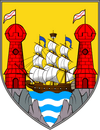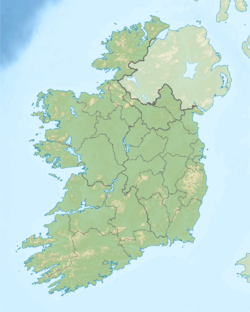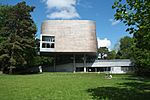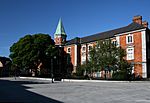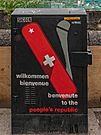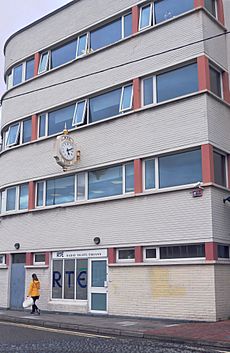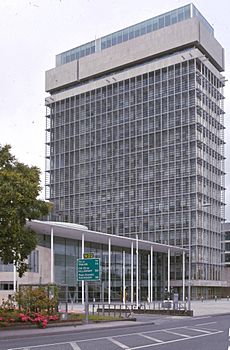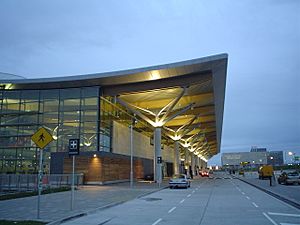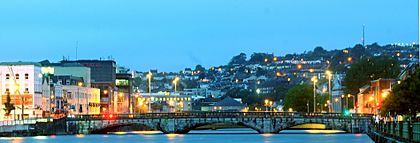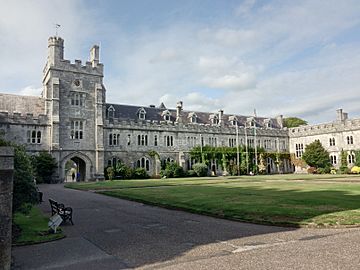Cork (city) facts for kids
Quick facts for kids
Cork
Corcaigh
|
||
|---|---|---|
|
City
|
||

From top, left to right: City Hall, the English Market, Quadrangle in UCC, the River Lee, Shandon Steeple
|
||
|
||
| Nicknames:
The Rebel City, Leeside, The Real Capital
|
||
| Motto(s):
Latin: Statio Bene Fida Carinis
"A safe harbour for ships" |
||
 |
||
| State | Ireland | |
| Province | Munster | |
| Region | Southern | |
| County | County Cork | |
| Founded | 6th century AD | |
| City rights | 1185 AD | |
| Area | ||
| • City | 187 km2 (72 sq mi) | |
| • Urban | 174 km2 (67 sq mi) | |
| • Metro | 820 km2 (320 sq mi) | |
| Population
(2022)
|
||
| • City | 224,004 | |
| • Density | 1,188/km2 (3,080/sq mi) | |
| • Metro
(2017)
|
305,222 | |
| • Demonym | Corkonian or Leesider | |
| Time zone | UTC0 (WET) | |
| • Summer (DST) | UTC+1 (IST) | |
| Eircode |
T12 and T23
|
|
| Area code(s) | 021 | |
| Vehicle index mark code |
C | |
Cork (Irish: Corcaigh [ˈkɔɾˠkəɟ]) is a big city in Ireland. Its name comes from an old Irish word, corcach, which means 'marsh' or 'swamp'. It is the second largest city in Ireland and the biggest in the province of Munster. In 2022, about 224,004 people lived there.
The city centre is built on an island between two parts of the River Lee. These parts meet near the sea, leading out to Cork Harbour. This harbour is one of the biggest natural harbours in the world.
Cork started as a religious settlement in the 6th century. Vikings helped it grow into a trading port around 915 AD. The city got its official charter from Prince John in 1185. Cork used to have strong walls around it, and you can still see parts of these old walls today. People sometimes call Cork "the Rebel City" because of its history of standing up for what it believed in. They also jokingly call it "the real capital" of Ireland.
Contents
Exploring Cork's Past
Cork began as a religious place, founded by Saint Finbarr in the 6th century. Between 915 and 922, Viking settlers arrived and started a trading port. This made Cork an important place for trade, like Dublin. The religious settlement and the Viking port worked together. The Vikings brought goods for the monastery, and maybe even helped protect it.
Prince John gave Cork its city rights in 1185. The city was once fully walled, and some parts of these walls still stand. For a long time, Cork was a place where English culture was strong, surrounded by Irish areas. Nearby Irish lords sometimes demanded "Black Rent" from the city to prevent attacks.
Wealthy merchant families controlled the city's government. They made money by trading wool and animal hides with Europe. They also imported salt, iron, and wine.
Around 1349, a terrible sickness called the Black Death arrived. It caused almost half of Cork's population to die. In 1491, Cork supported Perkin Warbeck, who claimed he should be the King of England. The mayor and other important citizens went with Warbeck, but their plan failed, and they were captured.
The leader of Cork was called the Mayor since 1318. In 1900, the title changed to Lord Mayor after Queen Victoria visited the city.
In the 1800s, Cork became a strong supporter of Irish independence. During the Irish War of Independence, British forces caused a lot of damage in Cork, burning down parts of the city centre. This event is known as the "Burning of Cork". Later, during the Irish Civil War, forces against a peace treaty held Cork for a while. However, the Irish National Army took it back in a sea attack.
City Boundary Changes
The city's size has grown over time. Its boundaries were made larger in 1840, 1955, and 1965.
In 2018, the government agreed to make Cork City even bigger. This included areas like Cork Airport, Douglas, and Ballincollig. This change made the city's area much larger and increased its population from 125,000 to 210,000 people. The new boundary officially started on May 31, 2019.
Cork's Weather
Cork has a mild oceanic climate, like most of Ireland. This means the weather changes often, with lots of rain but not many extreme temperatures. It rarely gets colder than 0°C (32°F) or hotter than 25°C (77°F).
Met Éireann has a weather station at Cork Airport, which is a few kilometres south of the city. The airport is higher up, so temperatures there can be a bit different from the city centre. Cork can sometimes flood because it is on the coast.
Cork Airport gets about 1239.2 mm (48.8 inches) of rain each year. It also sees hail about 6.5 days a year and snow or sleet about 9.5 days a year. However, snow rarely stays on the ground in the city itself. Cork is also a foggy city, especially in the mornings and winter. But it's also one of Ireland's sunniest cities, getting about 4 hours of sunshine each day.
| Climate data for Cork Airport (ORK) weather station (ICAO code: EICK, WMO identifier: 03955), 153m amsl, 1991−2020 normals | |||||||||||||
|---|---|---|---|---|---|---|---|---|---|---|---|---|---|
| Month | Jan | Feb | Mar | Apr | May | Jun | Jul | Aug | Sep | Oct | Nov | Dec | Year |
| Record high °C (°F) | 16.1 (61.0) |
14.0 (57.2) |
15.7 (60.3) |
21.2 (70.2) |
23.6 (74.5) |
27.5 (81.5) |
28.7 (83.7) |
28.3 (82.9) |
24.7 (76.5) |
21.4 (70.5) |
16.2 (61.2) |
13.8 (56.8) |
28.7 (83.7) |
| Mean daily maximum °C (°F) | 8.2 (46.8) |
8.5 (47.3) |
9.8 (49.6) |
12.0 (53.6) |
14.6 (58.3) |
17.0 (62.6) |
18.6 (65.5) |
18.4 (65.1) |
16.5 (61.7) |
13.3 (55.9) |
10.3 (50.5) |
8.7 (47.7) |
13.0 (55.4) |
| Daily mean °C (°F) | 5.7 (42.3) |
5.8 (42.4) |
6.8 (44.2) |
8.6 (47.5) |
11.1 (52.0) |
13.6 (56.5) |
15.2 (59.4) |
15.0 (59.0) |
13.4 (56.1) |
10.6 (51.1) |
7.8 (46.0) |
6.2 (43.2) |
10.0 (50.0) |
| Mean daily minimum °C (°F) | 3.2 (37.8) |
3.2 (37.8) |
3.9 (39.0) |
5.3 (41.5) |
7.6 (45.7) |
10.1 (50.2) |
11.7 (53.1) |
11.6 (52.9) |
10.2 (50.4) |
8.0 (46.4) |
5.3 (41.5) |
3.8 (38.8) |
7.0 (44.6) |
| Record low °C (°F) | −8.5 (16.7) |
−8.6 (16.5) |
−6.1 (21.0) |
−2.4 (27.7) |
−0.9 (30.4) |
2.4 (36.3) |
4.8 (40.6) |
4.9 (40.8) |
2.3 (36.1) |
−0.9 (30.4) |
−3.3 (26.1) |
−7.2 (19.0) |
−8.6 (16.5) |
| Average precipitation mm (inches) | 131.3 (5.17) |
97.2 (3.83) |
91.5 (3.60) |
86.5 (3.41) |
80.8 (3.18) |
83.3 (3.28) |
87.2 (3.43) |
94.6 (3.72) |
92.0 (3.62) |
131.2 (5.17) |
127.0 (5.00) |
136.6 (5.38) |
1,239.2 (48.79) |
| Average precipitation days (≥ 1.0 mm) | 16.7 | 13.7 | 13.4 | 12.3 | 12.0 | 10.1 | 11.9 | 12.2 | 11.9 | 15.1 | 15.6 | 16.8 | 161.7 |
| Average snowy days | 2.6 | 2.5 | 1.7 | 0.4 | 0.0 | 0.0 | 0.0 | 0.0 | 0.0 | 0.0 | 0.3 | 1.9 | 9.4 |
| Average relative humidity (%) (at 15:00 UTC) | 84.4 | 79.9 | 75.8 | 72.3 | 71.7 | 71.5 | 73.7 | 73.6 | 76.3 | 80.4 | 83.9 | 86.5 | 77.5 |
| Average dew point °C (°F) | 4.2 (39.6) |
3.9 (39.0) |
4.3 (39.7) |
5.4 (41.7) |
7.7 (45.9) |
10.1 (50.2) |
12.1 (53.8) |
12.1 (53.8) |
10.9 (51.6) |
8.6 (47.5) |
6.3 (43.3) |
4.8 (40.6) |
7.5 (45.6) |
| Mean monthly sunshine hours | 63.4 | 74.9 | 113.5 | 165.2 | 189.1 | 183.1 | 166.9 | 160.3 | 127.0 | 98.7 | 76.2 | 56.8 | 1,475.1 |
| Mean daily daylight hours | 8.4 | 10.0 | 11.9 | 13.9 | 15.7 | 16.6 | 16.2 | 14.6 | 12.6 | 10.6 | 8.8 | 7.9 | 12.3 |
| Average ultraviolet index | 1 | 1 | 2 | 4 | 5 | 6 | 6 | 5 | 4 | 2 | 1 | 0 | 3 |
| Source 1: Met Éireann | |||||||||||||
| Source 2: NOAA(dew point), WeatherAtlas (Daylight hours and UV Index) | |||||||||||||
Cork's Culture and Arts
Cork has a lively arts scene. Places like the Cork School of Music and the Crawford College of Art and Design help new artists and performers. University College Cork (UCC) also has theatre programs.
Important cultural spots include the Triskel Arts Centre, which has an independent cinema. The Firkin Crane is a dance venue. The Everyman Palace Theatre and the Granary Theatre host plays all year. Cork also hosts big events like the Cork Jazz Festival and the Cork Film Festival.
Many famous musicians come from Cork, including Rory Gallagher and John Spillane. Opera singers like Cara O'Sullivan are also from here.
The main music venues in Cork are the Cork Opera House and The Everyman. For writers, the Munster Literature Centre is a key place. Famous short story writers Frank O'Connor and Seán Ó Faoláin were from Cork.
Cork was the European Capital of Culture in 2005. In 2009, it was named one of the top 10 places to visit by Lonely Planet. They called Cork "sophisticated, vibrant and diverse."
There's a friendly competition between Cork and Dublin. Some people from Cork see themselves as different from the rest of Ireland. They call themselves "The Rebels" and their county the "Rebel County." This sometimes leads to funny sayings like calling Cork "the Real Capital" or celebrating the idea of "The People's Republic of Cork."
Local Food Traditions
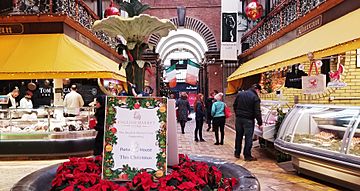
Cork has many unique food traditions. The English Market is a famous place to buy local foods. You can find fresh fish, meats, vegetables, cheeses, and breads there. During city festivals, food stalls often appear on streets like St. Patrick's Street.
The Marina Market opened in 2021 in the docklands. It's a large indoor space with many food vendors and also hosts events.
Cork Accent
The way people speak English in Cork is special. It's part of the Southwest dialect of Hiberno-English. The Cork accent often has rising and falling tones, and the overall sound can be higher pitched than other Irish accents. Cork English also has unique words that come from Irish and other languages.
Media in Cork
Broadcasting
RTÉ Cork has a radio and TV studio in the city centre. Other radio stations in Cork include Cork's 96FM and Cork's Red FM. There are also university and community radio stations.
Print Media
Cork is home to one of Ireland's main newspapers, the Irish Examiner. Its sister paper, The Echo, used to be sold by children called "Echo boys." You can still hear vendors selling The Echo in the city centre today. The Cork Independent is a popular free newspaper.
Interesting Places to Visit
Cork has many interesting buildings from different time periods. The Red Abbey is one of the few remaining buildings from the Medieval era.
There are two cathedrals in Cork. St. Mary's Cathedral is the Catholic cathedral, started in 1808. Saint Fin Barre's Cathedral belongs to the Church of Ireland and is very famous. It was built between 1862 and 1879.
St. Patrick's Street is the main shopping street. It's known for its beautiful buildings and is great for walking. The street is curved because it used to be a channel of the River Lee. The General Post Office is on Oliver Plunkett Street.
The Grand Parade is a tree-lined street with offices and shops. The South Mall is an older financial area with banks from the 1800s.
Many buildings in Cork are in the Georgian style. Modern buildings include County Hall, which was once the tallest building in Ireland. Outside County Hall, there's a sculpture of two men, known as 'Cha and Miah'.
Cork's most famous building is the church tower of St Anne in Shandon. It's a symbol of the city. One side is red sandstone, and the other is white limestone. On top, there's a weather vane shaped like a salmon.
Cork City Hall was rebuilt after being destroyed during the War of Independence. The UK Government helped pay for the new building in the 1930s.
Other popular places include Elizabeth Fort, the Cork Opera House, and the English Market. The English Market dates back to 1610.
Parks in Cork include Fitzgerald's Park, which has the Cork Public Museum. The Lough is a lake popular for angling. The Marina and Atlantic Pond are great for walking, jogging, and rowing.
Cork's Economy
Shopping and Retail
Cork has many places to shop, from modern shopping centres to local family-owned stores. You can find shopping centres in areas like Blackpool, Ballincollig, and Mahon Point Shopping Centre.
In the city centre, there are shopping areas like the "Cornmarket Centre" and "Merchant's Quay Shopping Centre." St. Patrick's Street is Cork's main shopping street and is one of the most expensive in Ireland. Many well-known stores have their roots in Cork, like Dunnes Stores.
Industries in Cork
Cork City is a major industrial centre. Many pharmaceutical companies, like Pfizer and Johnson & Johnson, have invested here. Apple Inc. has its European headquarters in Cork, employing over 3,000 people in manufacturing, research, and customer support. Other big tech companies like Logitech and EMC Corporation also have offices here.
The city is home to the Heineken Brewery, which makes Murphy's Irish Stout. The Beamish and Crawford brewery is also in Cork. A factory in Cork makes 45% of the world's Tic Tac sweets.
For many years, Ford Motor Company made cars in Cork. Henry Ford's grandfather was from nearby, which influenced the factory's location. Today, technology companies have largely replaced older manufacturing businesses. Amazon.com has offices at Cork Airport Business Park.
Cork's deep harbour allows large ships to bring in and take out goods easily. Cork Airport connects the city to Europe, and Cork Kent railway station provides good train links within Ireland.
Major Employers
Some of the biggest employers in Cork City (with over 1,000 employees) include:
- Cork University Hospital
- Apple Inc
- University College Cork
- Boston Scientific
- Cork City Council
- Munster Technological University (formerly Cork Institute of Technology)
- Bon Secours Hospital, Cork
- Retailers Supervalu and Centra
- The Irish Defence Forces at Collins Barracks
- Mercy University Hospital
Getting Around Cork
Air Travel
Cork Airport is Ireland's second busiest airport. It's located south of the city. Nine airlines fly from Cork to over 45 places in Europe.
Bus Services
Bus Éireann provides public bus services within Cork city. Routes connect the city centre to suburbs, colleges, and shopping centres. Buses to towns outside the city, like Ballincollig and Carrigaline, leave from the Parnell Place bus terminal. There are also shuttle buses to Cork Airport.
In 2019, Cork launched Ireland's first 24-hour bus route, the 220. This route connects Ballincollig and Carrigaline with the city centre. It runs once an hour during the early morning. This service has been very successful, with a 70% increase in passengers.
The National Transport Authority is planning new bus routes and improvements for Cork, similar to a project in Dublin. These plans include special bus lanes and 'bus gates' to make bus travel faster.
Long-distance buses from Parnell Place go to places all over Ireland, including Killarney, Waterford, and Dublin.
Harbour and Waterways
The Cross River Ferry connects Rushbrooke to Passage West. This ferry helps some commuters avoid traffic. The Port of Cork is located at Ringaskiddy, about 16 km (10 miles) southeast of the city. Brittany Ferries offers car ferry services from Cork to Roscoff in France.
Roads in Cork
Cork's roads have improved a lot over the years. The Cork South Link dual carriageway was built in the 1980s. The N25 South Ring Road, including the Jack Lynch Tunnel under the River Lee, was completed in the 1990s. These roads help traffic move around the city more easily. The M8 motorway links Cork directly to Dublin.
Since 2012, more cycle paths and bike stands have been added. In 2014, a public bike rental scheme started. You can rent bikes from 31 stations around the city.
Rail Travel
Railway History
Cork was once a very important city for railways in Ireland, with many stations. The main route from Dublin Heuston still runs today, ending at Kent Station in the city centre. This line also connects to towns like Cobh and Midleton to the east.
Cork also had other rail lines that went to places like Macroom and Blarney. There were even two tram networks in the city. The first one started in 1872 but closed a few years later. The second, the Cork Electric Tramways and Lighting Company, operated from 1898 until 1931. Trams stopped running because more people started using cars and buses.
Current Train Routes
Kent Station is Cork's main train station. From here, Irish Rail services go to many places in Ireland. Trains to Dublin leave every hour. You can also get to Killarney and Tralee, and to Limerick and Galway.
The Cork Suburban Rail system also starts at Kent Station. It connects to areas around Cork, including Little Island, Mallow, Midleton, Fota, and Cobh. In 2009, the line to Midleton was reopened, with new stations.
Education in Cork
Cork is a big centre for education in Ireland. Over 35,000 students attend colleges here. This means a higher percentage of students live in Cork than the national average.
University College Cork (UCC) is a major university offering many courses like arts, engineering, law, and medicine. It has been named "Irish University of the Year" four times since 2003. Munster Technological University (MTU), formerly Cork Institute of Technology (CIT), offers courses in computing, business, and engineering. It has also won "Institute of Technology of the Year" awards.
The National Maritime College of Ireland is in Cork. It's the only college in Ireland where you can study Nautical Studies and Marine Engineering. MTU also includes the Cork School of Music and Crawford College of Art and Design. The Cork College of Commerce is the largest 'College of Further Education' in Ireland.
Many research centres are linked to these colleges, helping with new ideas and inventions. These include the Tyndall National Institute for technology research and IMERC for marine energy. Both UCC and MTU have centres to help new companies get started.
Sports in Cork
Rugby, Gaelic football, hurling, and association football are very popular sports in Cork.
Gaelic Games

Hurling and football are the most watched sports in Cork. Cork has a strong history in hurling, winning 30 All-Ireland Championships. Gaelic football is also popular, with Cork winning 7 All-Ireland Senior Football Championship titles. Cork is the only county to have won both championships at least 7 times.
There are many Gaelic Athletic Association clubs in Cork City, like Blackrock and St. Finbarr's. The main stadiums are Páirc Uí Chaoimh and Páirc Uí Rinn. Camogie (hurling for girls) and women's Gaelic football are also growing in popularity.
Association Football
Cork City F.C. is the biggest and most successful football team in Cork. They have won three League of Ireland titles and play their home games at Turners Cross. Other Cork clubs have also won the league in the past.
Rugby
Rugby union is played at many levels in Cork. There are two top-division clubs: Cork Constitution and Dolphin R.F.C.. They play their home games in Ballintemple and Musgrave Park. Other clubs include Highfield and UCC.
Munster Rugby plays some of its matches at Musgrave Park. Many players from Cork city and county have helped Munster win the Heineken Cup in 2006 and 2008.
Water Sports
Cork has many water sports, including rowing and sailing. There are five rowing clubs on the River Lee. The "Ocean to City" race is held every year, with teams rowing 24 km (15 miles) from Crosshaven to Cork city centre. The Royal Cork Yacht Club in Crosshaven is the world's oldest yacht club.
Cricket
The main cricket club in Cork is Cork County Cricket Club, formed in 1874. They play at the Mardyke, which has hosted important matches. The Cork Cricket Academy helps introduce the sport to schools.
Other Sports
Cork has clubs for basketball (Neptune and UCC Demons), American football (Cork Admirals), and inline hockey. There are also clubs for golf, pitch and putt, hockey, tennis, and athletics.
The area is also known for road bowling. There are boxing and martial arts clubs in the city. Cork also has a successful Australian Rules Football team, the Leeside Lions.
Cork's Sister Cities
Cork is connected with other cities around the world. These "twin cities" include Cologne (Germany), Coventry (England), Rennes (France), San Francisco (USA), Swansea (Wales), and Shanghai (China).
Population of Cork
The population of Cork City and its suburbs was 224,004 in the 2022 census.
| Nationality | Population |
|---|---|
| 6,822 | |
| 3,075 | |
| 1,126 | |
| 960 | |
| 866 | |
| 824 | |
| 640 | |
| 543 | |
| 523 | |
| 520 |
In 2011, about 86% of people living in Cork were Irish citizens. The rest were from other EU countries or other parts of the world. By 2022, about 74.4% of the population was white Irish.
Regarding religion in 2022, 65% of people were Catholic. About 9% followed other religions, and 26% said they had no religion or did not state one.
Images for kids
-
Workers clearing rubble on St Patrick's street following the Burning of Cork.
See also
 In Spanish: Cork para niños
In Spanish: Cork para niños


